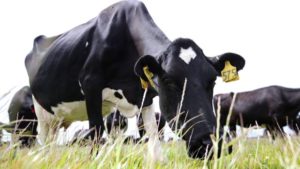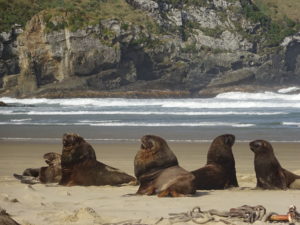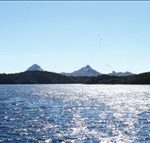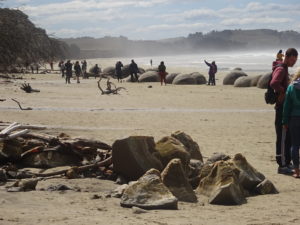Posts Tagged ‘Stewart Island Rakiura’
NZx: April 30th – an (un) certain future?
Naumai
Our environment is changing there can be no doubt. Whether this is due to factors such as human interference, over fishing, climate change, or a combination, many species in NZ face an (un) certain future.
In this blog we explore an (un) certain future for New Zealand sea lions or whakahao/rāpoka. You can out more about these remarkable mammals here and here.
My first encounter with New Zealand sea lions was deep in the myriad of waterways that make up Port Pegasus on Rakiura/Stewart Island. We had seen the sleek creamy brown outline of females in the water as we made our approach to land. Stepping ashore we began to wander through the primeval forest until suddenly a large brown male stood up on it’s hind flippers and roared at us from behind a prostrate rata tree. This was a truly remarkable NZx experience!
Since then I’ve been lucky enough to encounter both sexes on many parts of southern mainland New Zealand and other areas of Rakiura/Stewart Island. A recent journey to Dunedin and the Catlins led to further encounters with a variety of New Zealand sea lions. It is always intriguing when encountering threatened wildlife, that so many of the visitors in these “off the beaten track” places are from overseas. Don’t we as New Zealander’s value what we have?
On a parallel path the potential loss of the Hoiho from mainland New Zealand within a few decades is another indication of how fragile our environment is. You can find more about Hoiho here and here. Despite this bleak lookout for such an iconic species, advocacy around the issue and more importantly potential action, is frustratingly slow and deafeningly quiet.
Where does that leave New Zealand sea lions (whakahao/rāpoka) and their future as an iconic New Zealand species? We have previously commented on the wider issue of economic development and lack of input from tourism operators and environmental interests when it comes to New Zealand sea lions – see our March 2017 blogspot .
Much of our tourism product is based around the broader environment, without a coordinated approach to managing what we have, tourism itself is at risk.
How can we promote ourselves to the world as an environmentally sensitive country, that cares for our taonga, when so much of what makes this country special faces an (un) certain future?
Ka kite ano
NZxJune5th: Stewart Island Rakiura
Naumai
We read with interest the recent Stewart Island (Rakiura) Tourism Strategy www.stewartisland.co.nz. The strategy seeks to update an earlier version (2005) which, as such strategies often do, actually delivered a decrease in visitor numbers to the Island over the last five years.
The latest strategy states that the island has the potential to become a “must-see” nature destination.
With about 40,ooo visitors a year the potential is possibly there.
As a frequent recreational visitor and travelling there 2-3 times a year for work, I have been fortunate enough to see the changes that have occurred since I first worked there in the late 1970’s.
Key issues for the Island still remain and are little changed over the years. On our recent visit these issues included: not being able to receive instant confirmation of bookings, high prices and a low delivery of a quality experience, un-engaging guides and some run-down infrastructure.
We left knowing the resource i.e. nature is there, but the lack of engagment of visitors by their guides was a major diappointment. You can have the best natural resource in the world but if you don’t integrate it with an engaging approach to visitors then you simply dont maximise the experience.
As the recent visit showed these issues, amongst others, remain to be resolved if the Strategy is going to deliver on the stated potential.
Ka kite ano
Malcolm



